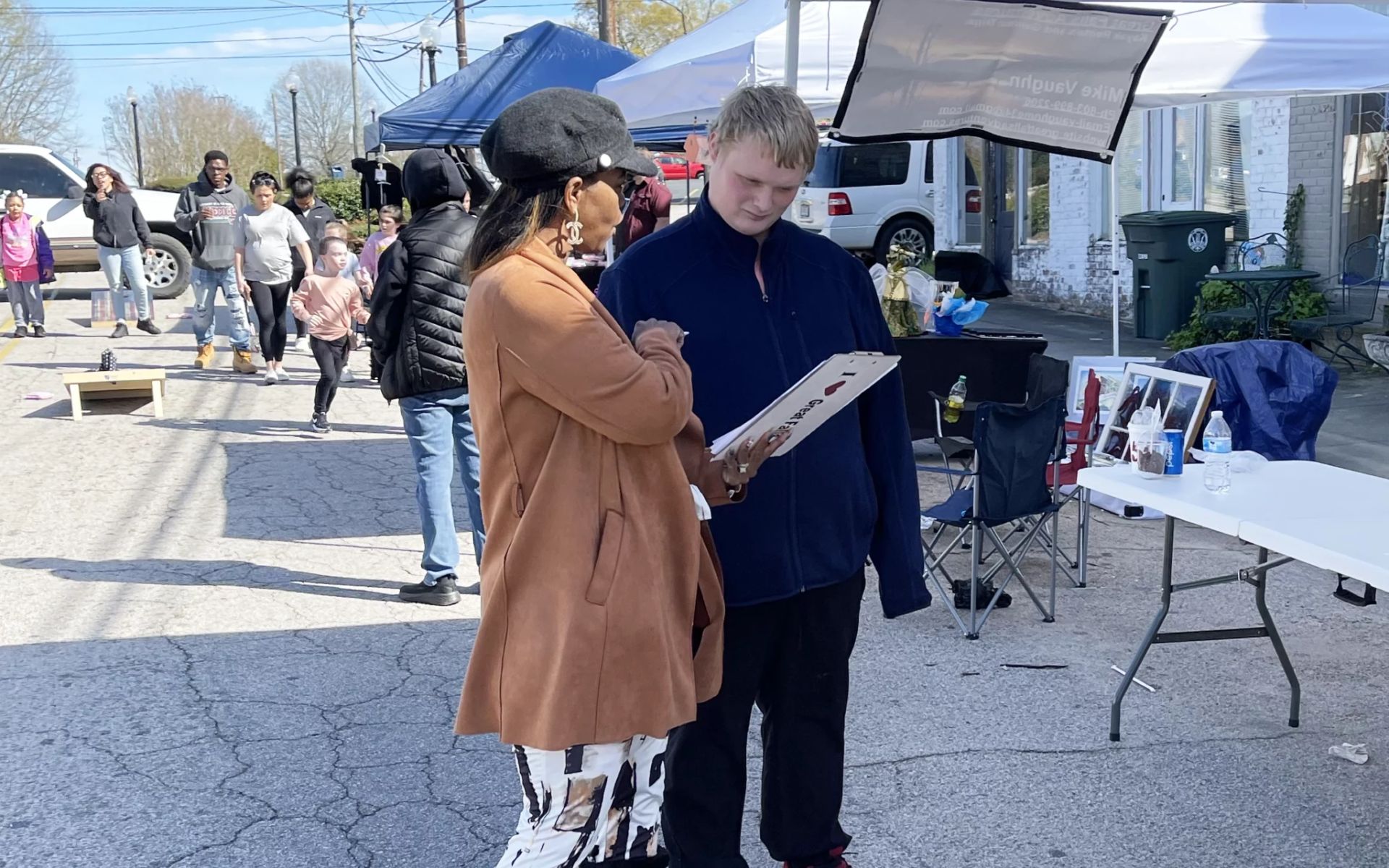Kershaw Invests In Community With New Ideas In Old Spaces

This article first appeared on the Our Towns Civic Foundation website on November 8, 2022, which you can see here.
A train depot that’s a museum. A former bank branch building that’s become a library. Another former bank that is serving as an early education center. Here is how this South Carolina town is repurposing buildings of the past to build up its future.
After a week-long trip through North Carolina and South Carolina in late August, I wrote about initial takeaways Michelle Ellia, my Our Towns colleague and fiancée, and I had here.
What we found, I wrote, was “different from what we expected when we began the trip, and a lot different from what you would expect if your only window in North Carolina and South Carolina is the national news.”
We saw, and will write about, different themes in different towns: Residents addressing the environment and sustainability topics in interesting and creative ways; a pronounced impact of both local and regional nonprofits along with national organizations supporting these communities at the town level; and how new ideas were breathing new life into old spaces.
This dispatch is about Kershaw, South Carolina, and the way it is using old places for new purposes.
Vestiges of Kershaw’s past remain in and around the South Carolina town.
In the 1820s, miners discovered gold just three miles outside of town on some 20,000 acres owned by Benjamin Haile. Production out of Haile Gold Mine, described locally as “the largest gold mine east of the Mississippi,” has ebbed and flowed as the mine has changed ownership over the years. It helped fund Confederate war efforts; it was sacked by Sherman’s troops; and as gold is being mined today, it is now the focus of environmental and sustainability efforts—as we’ll describe in upcoming reports.
We drove into Kershaw from the north, and saw the hulking, still-active Archer Daniels Midland soybean processing facility with its still-in-use railroad tracks. Those tracks serve as an ever-present reminder to residents and visitors alike of the area’s founding. In 1887, the Southern Railroad established Welsh’s Station on the Charleston, Cincinnati, and Chicago Railroad. A year later, the town incorporated.
This story is about residents who are excited to tell us about their town’s future, and show us that vision in the present, rather than longing for bygone eras. We saw that the new things were happening in old spaces. We also saw the impact of Community Heart & Soul®, a resident-driven community development initiative we have reported on before, in bringing the town together, and addressing critical issues in imaginative ways.
Today in Kershaw, gold mining and railways intersect on North Cleveland Street. Just one block off Hampton Street, the main street in the town of some 2,000 residents, Kershaw’s old rail depot now serves as both office space for the mine’s latest owner and operator, OceanaGold, and a museum housing both mining and railroad memorabilia open to the public.
Built in 1926, the Kershaw Depot, listed in the National Register, replaced the prior depot, which had been struck by lightning and destroyed in a fire. The current structure served as a terminal for both freight and passengers for nearly two decades until the Southern Railway sold it in the mid ‘40s. After, it lived several different lives, at times housing a craft shop, then a florist.
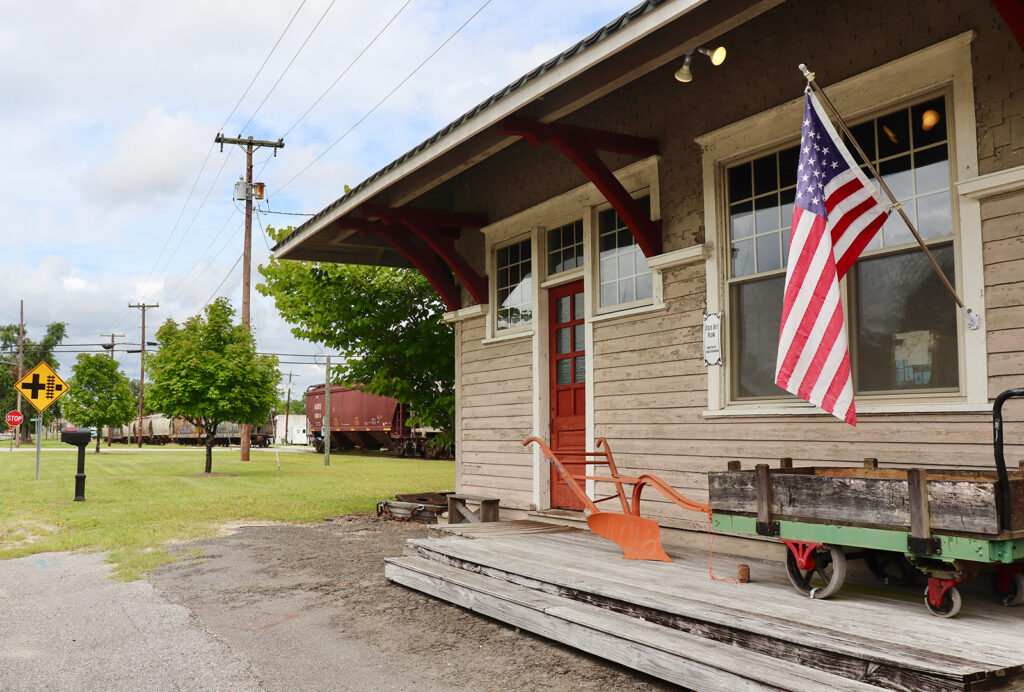
In 2010, the Haile Gold Mine purchased the property, saving it from demolition and preserving the interior woodworking. Renovations kept most of the original structure intact. Although it wasn’t open the day we were there, we were told that many of the artifacts inside have been donated by residents or were items found at the Haile Gold Mine site.
Standing in front of the then-depot-now-museum, Tiffany and Scott Whaley, who co-own and co-run their small business, Grassroots Advisors, and are heavily involved in the Kershaw Area Resource Exchange (KARE), brought up another part of South Carolina’s past that continues to cast a shadow into its present: The collapse of the textile industries.
“It was devastating,” Tiffany, who grew up in the rural southern part of the state and moved to Kershaw with Scott, her husband, in 2006, told us.
“That speaks to towns as big as Greenville in the Upstate, all the way down in Low Country in Charleston,” Scott, who grew up in Greenville, added. “But it was particularly hard on small towns, because in bigger towns there were other options. But in smaller towns, it was textiles. Everything was textiles. And once that left it, it was devastating.”
That word stayed with us. Not devastating, but was.
Walking up and down Hampton Street with the Whaleys, we saw a downtown with storefronts along its main street at near capacity. We tasted the successes of Creighton’s Creamery, a boutique ice cream shop and staple of the downtown core, run by a 31-year-old Cady and 29-year-old Adam Eubanks, another wife-husband duo working and living together in Kershaw. The couple started the business as a food truck that became so successful that they launched into a brick-and-mortar location where they also sell coffee made by a local roaster.


When I asked them why they were building their business in Kershaw, they asked me: “Why not?” adding, “Kershaw is home. This community supports us – why would we go somewhere else?”
The majority of their business comes from the some 12,000 people living in the encompassing 29067 ZIP code, Cady told me. Adam added that they rotate their flavors weekly so that their regulars don’t tire of their offerings. The couple told us they just purchased another building several blocks south, and were exploring ideas for another business along the main street stretch.
Across the street from Creighton’s Creamery is the Kershaw Branch of the Lancaster Public Library. From the outside, it looks like a standard one-story bank branch building, because that is what it used to be. Wells Fargo owned the building until 2017, when it closed that branch along with hundreds of others nationwide.

Then Lancaster County purchased the building. So began the plan to move the library branch from its shared space with other municipal resources just outside of the downtown to the standalone structure in the heart of the town. The doors of the brick building reopened anew in spring 2021.
Inside, the Teen Vault caught our eyes first. Rather than remove the bank’s vault, the county left it intact, and the library staff created a space for teens to gather to browse the young-adult collection, watch DVDs, and jot out ideas and leave messages to each other on a whiteboard. We’ve seen the emphasis, the intentional planning around teens in libraries elsewhere throughout the country, like here, and here, and here.
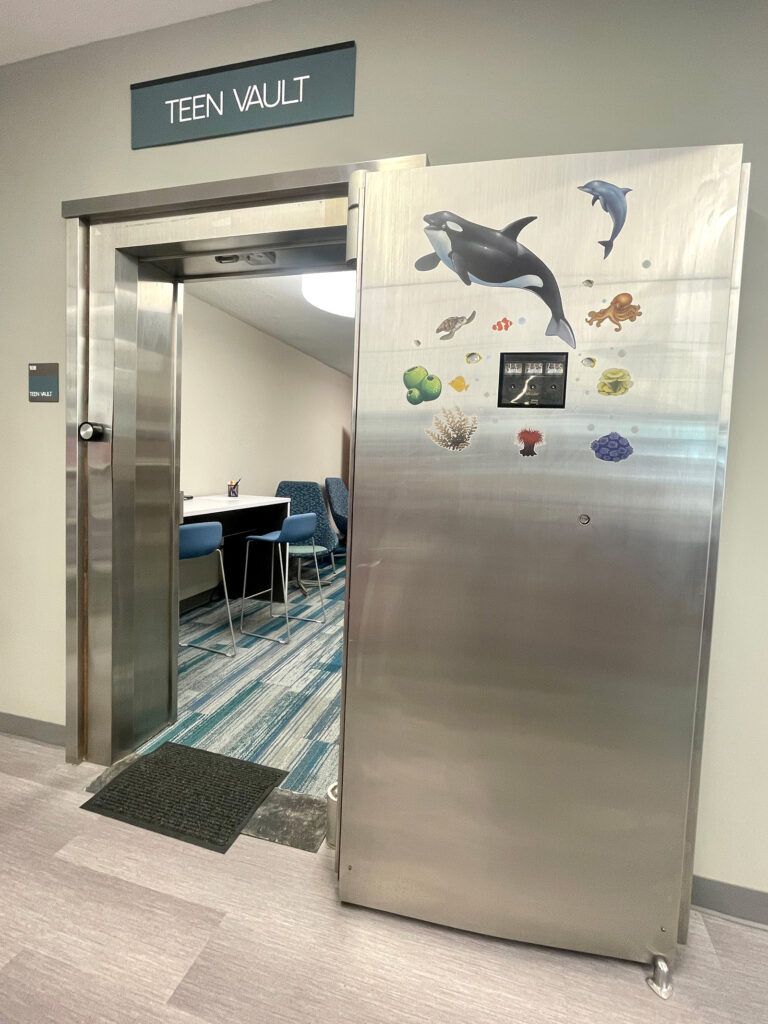

Outside the library, we noticed a lei-adorned cat statue. A few months ago, the cat wore sunglasses, Tiffany told me. As the seasons change, so do the outfits. The statues of both cats and dogs popped up throughout the county as part of a Lancaster County Council of the Arts creative placemaking programming program funded by the Arras Foundation, Cynthia Curtis, the foundation’s community investment officer, who joined us as we toured the town, told me.
The foundation’s investment is evident elsewhere in Kershaw, like at Stevens Park. There, the foundation collaborated with other local and regional partners, including the Kershaw Park Community Council and the town, to improve the walking trails to connect the park’s amenities, like spaces where the youngest citizens can gather to play, an outdoor amphitheater, a skate park, and even a swing set designed for Kershaw’s older residents so that grandparents who were looking to bring their grandkids could have playground equipment they, too, could use.
How did people in Kershaw decide to reinvest in left-behind buildings, rather than tearing them down or leaving them vacant? The answer is inevitably complex. But we heard that an important part was a process we’ve reported on from many communities. This was a collaboration involving a local-area foundation, in this case the Arras Foundation; the residents of Kershaw; and the Community Heart & Soul® process, which is designed to foster community cooperation on the values most residents share. (Community Heart & Soul is a partner and supporter of Our Towns reports.)
About seven years ago, the Arras Foundation was considering how it could help small communities in its area, like Kershaw.
“The Board and I were starting to think together about how to do authentic community engagement to listen to the needs of people. We knew we needed a process that brought the voices and needs of the people to the table,” Susan DeVenny, president and CEO of the foundation, told me over dinner in nearby Lancaster, where the foundation is located, later in the week.

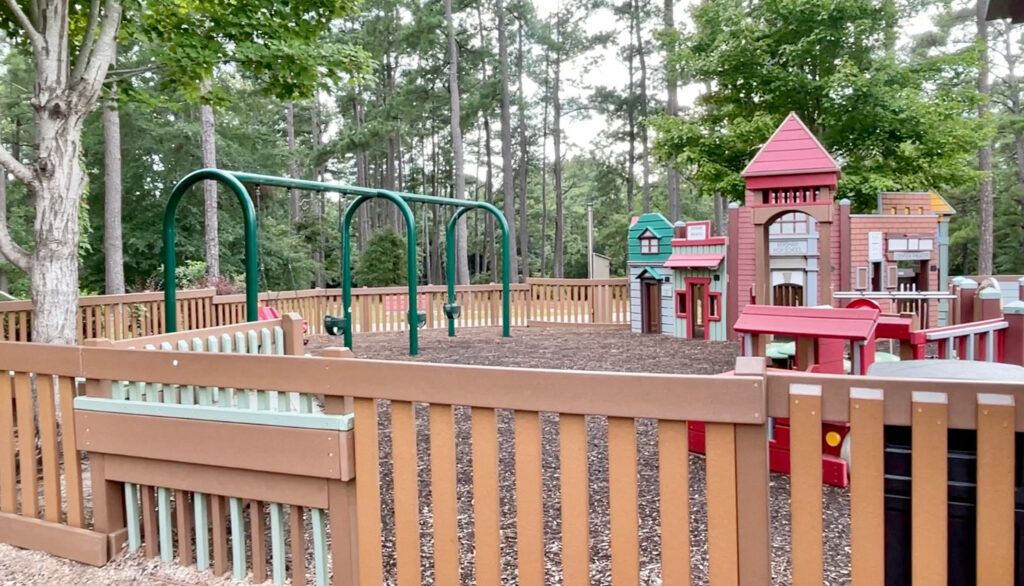
Shortly after those conversations began, Susan attended a conference in April 2016, where CH&S leadership was presenting, and found the model intriguing. After six months of discussions and strategic planning with CH&S, Arras brought the resident-driven community-development process to South Carolina. In 2017, Kershaw, along with nearby Fort Lawn, turned to Community Heart & Soul®. They were the first two South Carolina towns to adopt the Heart & Soul process.
There will be more to say in later reports about the Arras Foundation’s impact in and around Lancaster County. In Kershaw’s case, it provided the funding and resources for the Heart & Soul process, including deploying Cynthia as a CH&S Coach.
The local CH&S team in Kershaw, which includes the Whaleys, conducted over 1,300 surveys and gathered some 200 stories throughout the 29067 ZIP code. That data – what residents valued about their town, what they saw potential in, what challenges persisted – led to the seven Heart & Soul “values” Statements focused on local businesses, environment, culture, development, education, faith-community harmony, and small-town feel. One of the proclaimed “positive changes in the community” cited: A new library in the middle of downtown in the old Wells Fargo Building.
“Small town, big heart,” is how Mitch Lucas described Kershaw to me later in the afternoon standing a few blocks south on Hampton Street in front of the soon-to-be-opened Clyburn Early Childhood Center, in yet another reborn structure.

Mitch, a retired educator and former Town Manager who now calls himself a “worker bee,” was involved early in the Kershaw Heart & Soul initiative like the Whaleys. Like them, he has continued working on projects leading out of the Statements, including the development in the former Bank of Kershaw building.
Built in 1910, the building featured the bank on the first floor and a range of offices – from optometrists to insurance agents – on the second. It became vacant in the late ‘70s, and sat that way for some 40 years.
The Community Heart & Soul process had revealed a critical issue facing the town: Kershaw was in the middle of a childcare desert.
So, the town put together a grant application in November 2019 to South Carolina First Steps, which the state’s General Assembly established in 1999 to narrow the educational readiness gap. Kershaw received $600,000 in May 2020, and renovations began shortly after the announcement. In August, the project received additional support, as the Arras Foundation awarded a $350,000 grant to support the second phase of the project. The Town of Kershaw leveraged this grant for additional funding resources.

Mitch guided us through the 10,000 square-foot building, named after a former mayor, William R. Clyburn, Senior, from whom the town purchased the building at a reduced rate. On the first floor, we saw three classrooms – one classroom for three-year olds, and two for four-year olds – getting the finishing touches when we were there so that they would soon welcome Kershaw’s youngest residents ready to learn.
There was the soon-to-be kitchen space to feed the youngsters during the day, and the parent-teacher room where staff would help “teach them how to be their first teachers,” Mitch told me. The extended day (from around 7 a.m. to 5:30 p.m.) and extended year (230 days, rather than the more standard 180) will be free of charge to families that qualify, Mitch said.
Following Mitch up the dusty staircase to the second floor, we imagined how the first floor looked before the renovations. Layers of dust. Cobwebs strung out in the corners. Cracked paint peeling around doorways.
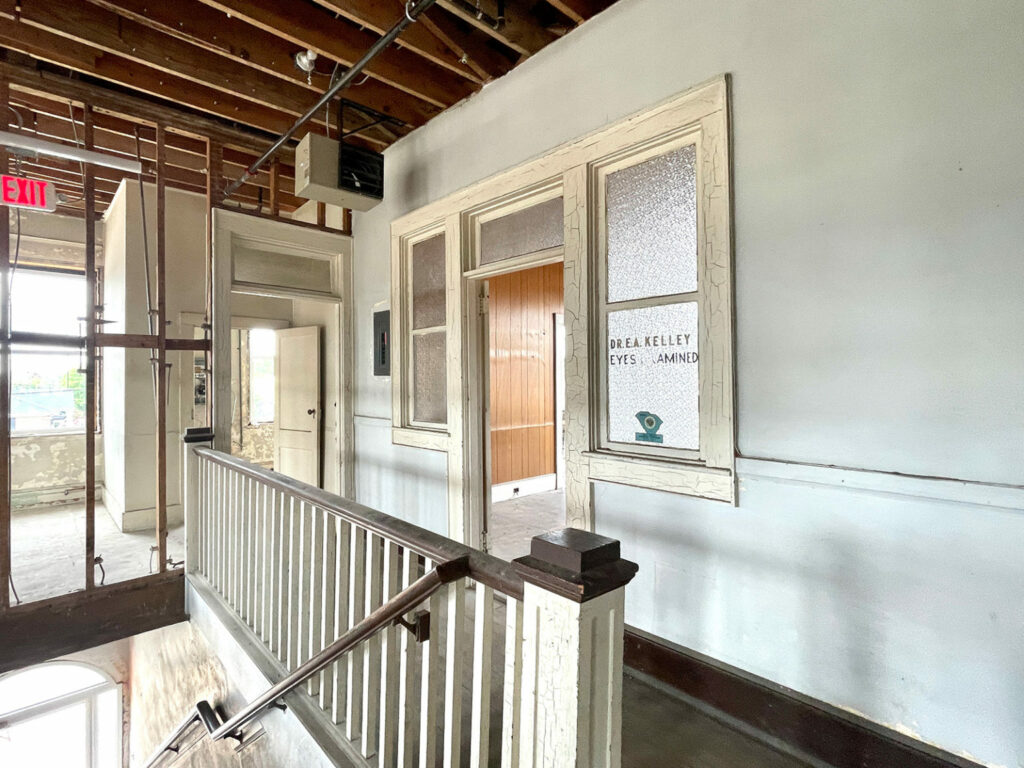

Still much as it had been for some 40 years, it presents as the blank canvas with plans drafted to serve as a community center, Mitch told us. Former offices, like the one where his uncle sold insurance, reimagined as computer labs and meeting and event spaces.
For that, funds have been secured from South Carolina’s Capital Project Sales Tax, or “Penny Tax.”
“We put together a grant, and Heart & Soul was all my presentation,” Mitch told me.
From the outside, Kershaw’s buildings – a train depot, two bank buildings – tell the story of the past. But inside – a museum, a library, and an early education center – they tell the story of the town’s future, being written presently by its residents.



